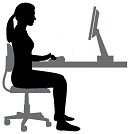
We conduct individual work station assessments.
What's unique about the assessments is that as well as assessing the
workstation and adjusting the seat, the desk and the monitor to give the
best possible ergonomic position, we also provide
an assessment of the
risk that the people are running of becoming victims of
musculo-skeletal
dysfunction due to poor posture and
lack of strength and flexibility.
It is frequently the case that people are neither strong
enough nor flexible enough to keep themselves in a good sitting posture
for long periods of time. The net effect is poor posture - the 'S'
shaped curve of the spine becomes a 'C' shape - leading to
musculo-skeletal dysfunction, particularly of the lower back, shoulder
and wrist.
And it is
usually the case that it's not what happens at work that causes the
dysfunction, but what doesn't happen at home. Lack of strength and
flexibility lies at the heart of most musculo-skeletal dysfunctions.
Sitting down is a major cause of musculo-skeletal dysfunction in the
workplace. It's a killer. If you don't sit up straight you're at great risk of future
musculo-skeletal dysfunction. If you don't maintain the flexibility of
the muscles of your calves, hamstrings and buttocks you're also at great
risk.
We encourage people to stand up for as
much of the day as they can. Some people can adjust the desk to allow
this to happen, others need to have a box that they can put their
keyboard and mouse on.
|
• |
We alert people to the distinction
between injury and dysfunction. Most of the musculo-skeletal incidents
happening to people are
dysfunctions caused by lifestyle neglect - they don't do any
strengthening and flexibility exercises. Muscles are becoming weaker and
tighter by the week, dragging bones out of alignment. They are
not injuries.
|
|
|
|
|
• |
We teach people how to sit up straight. Tip: make sure your seat
is in close so your abdomen is touching the desk and the back of the
seat is giving good support to the thoracic part of your spine.
|
|
|
|
|
• |
We teach people the exercises
they need to do to keep their pelvis and spinal column in correct
alignment. |
|
|
|
|
• |
We show those with musculo-skeletal
dysfunction what's the likely cause of their dysfunction and the
exercises they need to do to fix it up. Remember, it's a big ask
expecting to get better by having someone do something to you. |
THE CHAIR AND THE DESK
It is frequently the case that the chair and the desk are not set up to
give
good support to the hips and spinal column, thereby placing staff
members
at risk of postural misalignment.
It's also interesting to note that the chair and the desk are frequently
unfairly
blamed for a musculo-skeletal incident. Usually it is the chair that
gets replaced. The person becomes weaker and more inflexible as time
goes on and the dysfunction reappears. The chair will be vindicated.
Both employers and employees need to be aware of this situation.
OVER USE OR UNDER USE?
Most shoulder and wrist injuries are caused, not by overuse, but by
under-use. People do not have a regular and systematic strength and
flexibility program. They are not doing the exercises which will protect
them from the dysfunction that comes from sitting down for long periods
of time.
At first sight sitting down and typing all day looks like a pretty cushy
job. However, if anyone spends long periods of time sitting down and
don't have a regular strength and flexibility program, the muscles on
the back side of the lower part of the body (calves, hamstrings and
buttocks) become shortened, the pelvis
tilts back, the shoulders come forward and they end up with lower back,
shoulder and wrist dysfunction. The blame is unfairly sheeted home to
the employer.
So, in a nutshell we
a. make sure the furniture is set up correctly
b. measure the risk of low levels of strength and
flexibility
through the use of the Ten Point Musculo-skeletal Risk
Screen.
c. prepare a report on the risk to the employer.
For best results it is recommended that staff attend a two hour Crook
Back Clinic at the same time as the ergonomic assessment is done.